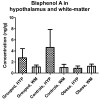Distribution of Non-Persistent Endocrine Disruptors in Two Different Regions of the Human Brain
- PMID: 28902174
- PMCID: PMC5615596
- DOI: 10.3390/ijerph14091059
Distribution of Non-Persistent Endocrine Disruptors in Two Different Regions of the Human Brain
Abstract
Non-persistent endocrine disrupting chemicals (npEDCs) can affect multiple organs and systems in the body. Whether npEDCs can accumulate in the human brain is largely unknown. The major aim of this pilot study was to examine the presence of environmental phenols and parabens in two distinct brain regions: the hypothalamus and white-matter tissue. In addition, a potential association between these npEDCs concentrations and obesity was investigated. Post-mortem brain material was obtained from 24 individuals, made up of 12 obese and 12 normal-weight subjects (defined as body mass index (BMI) > 30 and BMI < 25 kg/m², respectively). Nine phenols and seven parabens were measured by isotope dilution TurboFlow-LC-MS/MS. In the hypothalamus, seven suspect npEDCs (bisphenol A, triclosan, triclocarban and methyl-, ethyl-, n-propyl-, and benzyl paraben) were detected, while five npEDCs (bisphenol A, benzophenone-3, triclocarban, methyl-, and n-propyl paraben) were found in the white-matter brain tissue. We observed higher levels of methylparaben (MeP) in the hypothalamic tissue of obese subjects as compared to controls (p = 0.008). Our findings indicate that some suspected npEDCs are able to cross the blood-brain barrier. Whether the presence of npEDCs can adversely affect brain function and to which extent the detected concentrations are physiologically relevant needs to be further investigated.
Keywords: bisphenol-A; brain; hypothalamus; methylparaben; obesity; parabens; phenols.
Conflict of interest statement
The authors declare no conflict of interest.
Figures




Similar articles
-
Widespread occurrence of bisphenol A diglycidyl ethers, p-hydroxybenzoic acid esters (parabens), benzophenone type-UV filters, triclosan, and triclocarban in human urine from Athens, Greece.Sci Total Environ. 2014 Feb 1;470-471:1243-9. doi: 10.1016/j.scitotenv.2013.10.089. Epub 2013 Nov 16. Sci Total Environ. 2014. PMID: 24246946
-
Rapid determination of nine parabens and seven other environmental phenols in urine samples of German children and adults.Int J Hyg Environ Health. 2014 Nov;217(8):845-53. doi: 10.1016/j.ijheh.2014.06.003. Epub 2014 Jun 20. Int J Hyg Environ Health. 2014. PMID: 25008406
-
Assumed non-persistent environmental chemicals in human adipose tissue; matrix stability and correlation with levels measured in urine and serum.Environ Res. 2017 Jul;156:120-127. doi: 10.1016/j.envres.2017.03.030. Epub 2017 Mar 22. Environ Res. 2017. PMID: 28342347
-
Possible endocrine disrupting effects of parabens and their metabolites.Reprod Toxicol. 2010 Sep;30(2):301-12. doi: 10.1016/j.reprotox.2010.03.011. Epub 2010 Apr 8. Reprod Toxicol. 2010. PMID: 20381602 Review.
-
Exposures to Endocrine Disrupting Chemicals in Consumer Products-A Guide for Pediatricians.Curr Probl Pediatr Adolesc Health Care. 2017 May;47(5):107-118. doi: 10.1016/j.cppeds.2017.04.002. Epub 2017 May 17. Curr Probl Pediatr Adolesc Health Care. 2017. PMID: 28526231 Review.
Cited by
-
The Presence of Triclosan in Human Hair Samples in Poland-A Pilot Study.Int J Environ Res Public Health. 2022 Mar 23;19(7):3796. doi: 10.3390/ijerph19073796. Int J Environ Res Public Health. 2022. PMID: 35409481 Free PMC article.
-
Benzophenones in the Environment: Occurrence, Fate and Sample Preparation in the Analysis.Molecules. 2023 Jan 27;28(3):1229. doi: 10.3390/molecules28031229. Molecules. 2023. PMID: 36770896 Free PMC article. Review.
-
Prenatal Exposure to Triclocarban Impairs ESR1 Signaling and Disrupts Epigenetic Status in Sex-Specific Ways as Well as Dysregulates the Expression of Neurogenesis- and Neurotransmitter-Related Genes in the Postnatal Mouse Brain.Int J Mol Sci. 2021 Dec 4;22(23):13121. doi: 10.3390/ijms222313121. Int J Mol Sci. 2021. PMID: 34884933 Free PMC article.
-
Multigenerational Consequences of Prenatal Exposure to Benzophenone-3 Demonstrate Sex- and Region-Dependent Neurotoxic and Pro-Apoptotic Effects in Mouse Brain.Toxics. 2024 Dec 13;12(12):906. doi: 10.3390/toxics12120906. Toxics. 2024. PMID: 39771121 Free PMC article.
-
Possible Obesogenic Effects of Bisphenols Accumulation in the Human Brain.Sci Rep. 2018 May 29;8(1):8186. doi: 10.1038/s41598-018-26498-y. Sci Rep. 2018. PMID: 29844501 Free PMC article.
References
-
- Zoeller R.T., Brown T.R., Doan L.L., Gore A.C., Skakkebaek N.E., Soto A.M., Woodruff T.J., Vom Saal F.S. Endocrine-disrupting chemicals and public health protection: A statement of principles from The Endocrine Society. Endocrinology. 2012;153:4097–4110. doi: 10.1210/en.2012-1422. - DOI - PMC - PubMed
MeSH terms
Substances
LinkOut - more resources
Full Text Sources
Other Literature Sources

